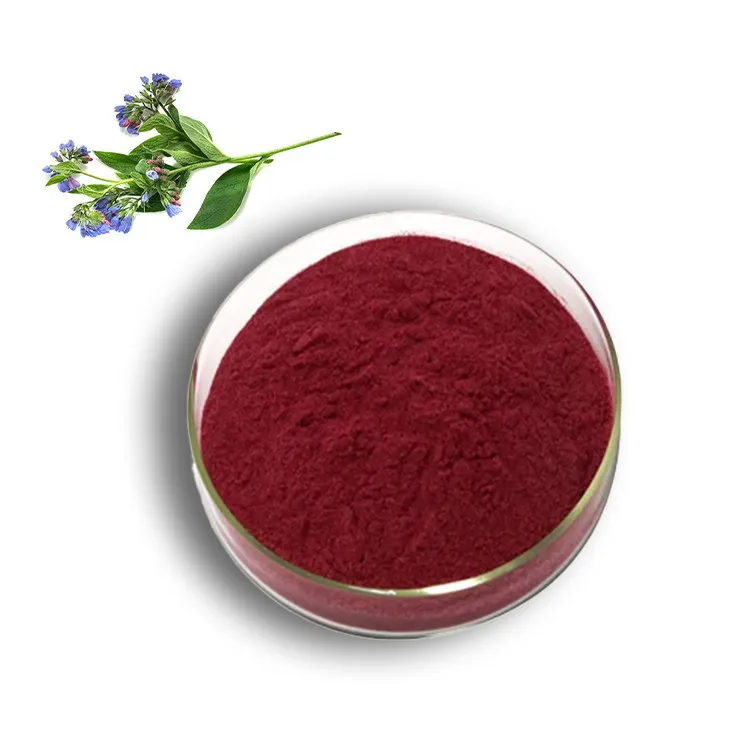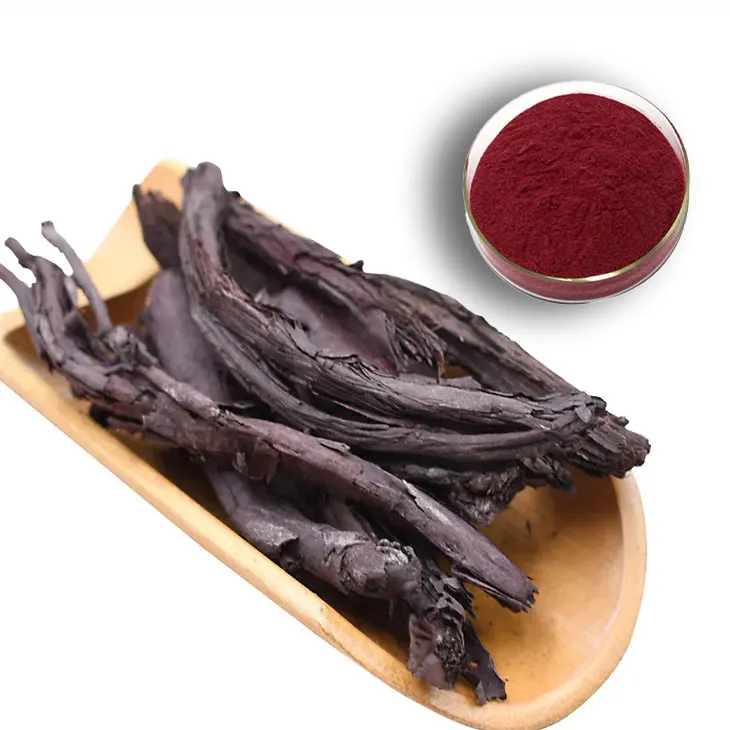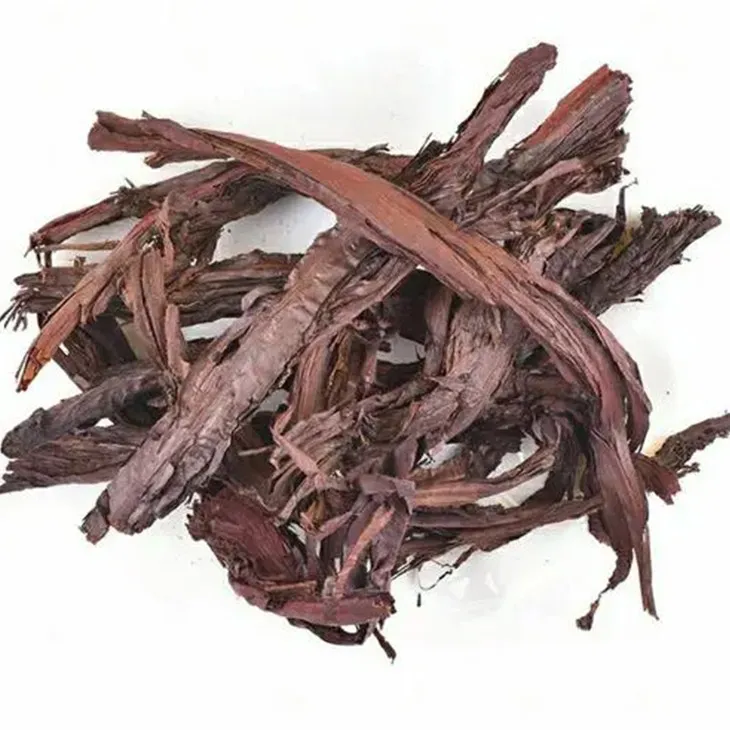- 0086-571-85302990
- sales@greenskybio.com
The process of extracting shikonin naphthoquinone compounds from Lithospermum erythrorhizon extract.
2024-11-27

1. Introduction
Shikonin naphthoquinone compounds derived from Lithospermum erythrorhizon extract have become a focal point in various research fields due to their remarkable pharmacological activities. These activities include anti - inflammatory, antibacterial, antiviral, and antitumor effects. As a result, the extraction of these compounds has gained significant importance.
Traditional extraction methods, such as solvent extraction, have been used for a long time. However, they have certain limitations. For example, they may require large amounts of solvents, have low extraction efficiency, and may cause environmental pollution. In recent years, new extraction techniques have emerged to overcome these drawbacks.

2. Traditional Extraction Methods
2.1 Solvent Extraction
Solvent extraction is one of the most common traditional methods. It involves using organic solvents, such as ethanol or petroleum ether, to dissolve Shikonin naphthoquinone compounds from Lithospermum erythrorhizon roots or other parts.
The process typically includes the following steps:
- First, the plant material is dried and ground into a fine powder.
- Then, the powder is soaked in the selected solvent for a certain period, usually several hours to days.
- After that, the mixture is filtered to separate the solid residue from the solvent - containing the target compounds.
- Finally, the solvent is evaporated to obtain the Shikonin naphthoquinone extract.
However, this method has some disadvantages. It may lead to the extraction of other unwanted substances along with the target compounds, reducing the purity of the final product. Also, the large - scale use of organic solvents can be costly and environmentally unfriendly.
2.2 Soxhlet Extraction
Soxhlet extraction is another traditional extraction technique. It is a continuous extraction method that uses a Soxhlet apparatus.
The principle of this method is based on the repeated circulation of the solvent through the plant material. The solvent is heated and vaporized in the Soxhlet apparatus, then condensed and dripped back onto the plant sample. This process is repeated multiple times to ensure a more complete extraction.
Advantages of Soxhlet extraction include its ability to extract compounds more thoroughly compared to simple solvent extraction. However, it also has limitations. It is time - consuming, usually taking several hours to complete a single extraction. Additionally, like solvent extraction, it uses a large amount of solvent, which may pose environmental and cost - related issues.

3. New Extraction Techniques
3.1 Supercritical Fluid Extraction (SFE)
Supercritical fluid extraction (SFE) is a relatively new and advanced extraction technique. In this method, a supercritical fluid, usually carbon dioxide (CO₂), is used as the extraction solvent.
The principle of SFE lies in the unique properties of supercritical fluids. Supercritical CO₂ has properties between those of a gas and a liquid. It has a high diffusivity like a gas, which enables it to penetrate into the plant matrix quickly, and a density similar to that of a liquid, allowing it to dissolve the target compounds effectively.
Advantages of SFE are numerous:
- It is a green extraction method as CO₂ is non - toxic, non - flammable, and easily available. After extraction, the CO₂ can be easily removed from the extract by reducing the pressure, leaving behind a relatively pure product.
- The extraction process can be controlled by adjusting parameters such as pressure, temperature, and flow rate. This allows for the selective extraction of shikonin naphthoquinone compounds, reducing the extraction of unwanted substances.
- It has a relatively short extraction time compared to traditional methods, which can improve the extraction efficiency.
However, SFE also has some challenges. The equipment for SFE is relatively expensive, which may limit its widespread application in small - scale or low - budget laboratories.
3.2 Ultrasound - Assisted Extraction (UAE)
Ultrasound - assisted extraction (UAE) is another innovative extraction technique. It utilizes ultrasonic waves to enhance the extraction process.
When ultrasonic waves are applied to the extraction system, cavitation phenomena occur. Cavitation bubbles are formed, grow, and then collapse violently. These collapses generate high - intensity shock waves and micro - jets, which can disrupt the cell walls of the plant material, facilitating the release of shikonin naphthoquinone compounds into the solvent.
Benefits of UAE include:
- It significantly reduces the extraction time. Compared to traditional solvent extraction, UAE can complete the extraction in a much shorter time, usually within minutes to hours.
- It can improve the extraction yield. The disruption of cell walls by ultrasonic waves allows for more complete extraction of the target compounds.
- The equipment for UAE is relatively simple and inexpensive, making it more accessible for laboratories with limited budgets.
Nevertheless, one drawback of UAE is that the ultrasonic energy may cause degradation of some thermally sensitive compounds if not properly controlled.
3.3 Microwave - Assisted Extraction (MAE)
Microwave - assisted extraction (MAE) is also a new extraction technology. It uses microwaves to heat the extraction system.
The mechanism of MAE is based on the interaction between microwaves and polar molecules in the plant material and the solvent. Microwaves can cause rapid heating of the polar molecules, leading to an increase in temperature and pressure within the plant cells. This results in the rupture of cell walls and the release of shikonin naphthoquinone compounds.
Advantages of MAE are:
- It is a fast extraction method. The extraction time can be as short as a few minutes, which is much faster than traditional extraction methods.
- It can improve the extraction efficiency and yield. The selective heating of polar molecules by microwaves can enhance the extraction of target compounds while reducing the extraction of non - polar substances.
However, MAE also has some limitations. The non - uniform heating of the sample may occur, which can affect the reproducibility of the extraction results. Also, the equipment for MAE needs to be carefully calibrated to ensure accurate control of the microwave power and extraction time.

4. Optimization of Extraction Conditions
Optimizing the extraction conditions is crucial for obtaining high - quality shikonin naphthoquinone compounds with a high yield. The following factors need to be considered:
4.1 Solvent Selection
The choice of solvent is an important factor. For traditional solvent extraction methods, different solvents have different solubilities for shikonin naphthoquinone compounds. Ethanol is a commonly used solvent due to its relatively good solubility and low toxicity. However, in some cases, a mixture of solvents may be more effective. For example, a mixture of ethanol and water may be used to adjust the polarity of the solvent system, which can improve the selectivity of extraction.
4.2 Temperature
Temperature has a significant impact on the extraction process. In methods such as SFE, UAE, and MAE, the appropriate temperature can enhance the extraction efficiency. However, too high a temperature may cause the degradation of shikonin naphthoquinone compounds. For example, in UAE, if the temperature is too high during the ultrasonic - assisted extraction, the thermally sensitive shikonin compounds may be damaged. Therefore, it is necessary to find the optimal temperature range for each extraction method.
4.3 Pressure
Pressure is mainly a factor in SFE. Different pressures can affect the density and solubility of the supercritical fluid. By adjusting the pressure, the extraction selectivity and efficiency can be optimized. Generally, a higher pressure can increase the solubility of shikonin naphthoquinone compounds in supercritical CO₂, but it also requires more complex and expensive equipment to maintain high pressure.
4.4 Extraction Time
The extraction time also affects the yield and quality of the extracted compounds. For traditional methods like Soxhlet extraction, a longer extraction time may be required to achieve a relatively high yield. However, for new methods such as UAE and MAE, a shorter extraction time can usually obtain a satisfactory yield. Prolonging the extraction time may not necessarily increase the yield but may increase the extraction of unwanted substances.
5. Application Prospects
5.1 Medical Applications
Shikonin naphthoquinone compounds have great potential in the medical field. Their anti - inflammatory properties can be used to develop drugs for treating inflammatory diseases such as arthritis. The antibacterial and antiviral activities make them candidates for the development of new antibiotics and antiviral agents. Moreover, their antitumor effects have attracted much attention in cancer research. They may be used alone or in combination with other drugs to treat various types of cancers.
5.2 Cosmetic Applications
In the cosmetics industry, shikonin naphthoquinone compounds can be used in various products. Their antioxidant properties can help prevent skin aging, reduce wrinkles, and protect the skin from free - radical damage. They can also be used in products for treating skin diseases such as eczema and psoriasis due to their anti - inflammatory effects.
5.3 Other Applications
Besides medicine and cosmetics, shikonin naphthoquinone compounds may also find applications in other fields. For example, they may be used in the food industry as natural preservatives due to their antibacterial properties. In the textile industry, they may be used to develop new types of dyes with unique colors and good colorfastness.
6. Conclusion
In conclusion, the extraction of shikonin naphthoquinone compounds from Lithospermum erythrorhizon extract is an important area of research. Traditional extraction methods have certain limitations, but new techniques such as SFE, UAE, and MAE offer more efficient and environmentally friendly alternatives. Optimization of extraction conditions is essential for improving the yield and quality of the extracted compounds. The extracted shikonin naphthoquinone compounds have broad application prospects in medicine, cosmetics, and other fields, which further promotes the research and development of extraction techniques.
FAQ:
What are the traditional extraction methods for shikonin naphthoquinone compounds from Lithospermum erythrorhizon extract and what are their limitations?
Traditional extraction methods for shikonin naphthoquinone compounds from Lithospermum erythrorhizon extract include solvent extraction. The main limitation of solvent extraction is that it may require a large amount of organic solvents, which are not only costly but also may have potential environmental pollution problems. And the extraction efficiency may not be as high as some modern extraction techniques.
What are the new extraction techniques for shikonin naphthoquinone compounds from Lithospermum erythrorhizon extract?
Some new extraction techniques include supercritical fluid extraction. Supercritical fluid extraction uses supercritical fluids (such as supercritical CO2) as the extraction solvent. It has the advantages of high selectivity, fast extraction speed, and environmental friendliness. Another new technique is ultrasonic - assisted extraction. Ultrasonic - assisted extraction uses ultrasonic waves to disrupt plant cells, which can enhance the mass transfer process and improve the extraction efficiency.
How to optimize the extraction conditions for shikonin naphthoquinone compounds?
To optimize the extraction conditions, several factors need to be considered. For example, in solvent extraction, the choice of solvent type, extraction time, extraction temperature, and the ratio of raw material to solvent are important. For supercritical fluid extraction, pressure, temperature, and flow rate of the supercritical fluid need to be optimized. By using experimental design methods such as response surface methodology, the optimal combination of these factors can be determined to improve the yield and quality of shikonin naphthoquinone compounds.
What are the pharmacological activities of shikonin naphthoquinone compounds?
Shikonin naphthoquinone compounds have a variety of pharmacological activities. They have anti - inflammatory properties, which can reduce inflammation by inhibiting the production of inflammatory mediators. They also have antioxidant activity, which can scavenge free radicals in the body and protect cells from oxidative damage. In addition, they have shown potential anti - tumor activity, which may be related to their ability to induce apoptosis in tumor cells.
What are the application prospects of shikonin naphthoquinone compounds in medicine?
In medicine, shikonin naphthoquinone compounds have broad application prospects. Due to their anti - inflammatory and antioxidant properties, they can be used in the treatment of various inflammatory diseases such as dermatitis. Their potential anti - tumor activity also makes them candidates for the development of new anti - cancer drugs. Moreover, they may be used in the treatment of cardiovascular diseases because of their effects on blood vessels and blood lipid regulation.
Related literature
- Title: Advanced Extraction Techniques for Shikonin from Lithospermum erythrorhizon"
- Title: "Pharmacological Properties and Applications of Shikonin Naphthoquinone Compounds"
- Title: "Optimization of Extraction Conditions for Shikonin in Lithospermum erythrorhizon Extract"
- ▶ Hesperidin
- ▶ citrus bioflavonoids
- ▶ plant extract
- ▶ lycopene
- ▶ Diosmin
- ▶ Grape seed extract
- ▶ Sea buckthorn Juice Powder
- ▶ Beetroot powder
- ▶ Hops Extract
- ▶ Artichoke Extract
- ▶ Reishi mushroom extract
- ▶ Astaxanthin
- ▶ Green Tea Extract
- ▶ Curcumin Extract
- ▶ Horse Chestnut Extract
- ▶ Other Problems
- ▶ Boswellia Serrata Extract
- ▶ Resveratrol Extract
- ▶ Marigold Extract
- ▶ Grape Leaf Extract
- ▶ blog3
- ▶ blog4
-
Honeysuckle pollen of the best quality.
2024-11-27
-
Chinese Senna Leaf Extract Suppliers.
2024-11-27
-
Organic Dandelion Root Extract, Australia.
2024-11-27
-
The best bitter gourd extract in 2024.
2024-11-27
-
The best baicalin in nature.
2024-11-27
-
Chinese lily extract manufacturers.
2024-11-27
-
Nature's best β - carotene.
2024-11-27
-
Standard - process Coenzyme Q10.
2024-11-27
-
Reishi mushroom extract
2024-11-27
-
Bilberry Extract
2024-11-27
-
Senna Leaf Extract
2024-11-27
-
Konjac Powder
2024-11-27
-
Buckthorn bark extract
2024-11-27
-
Dandelion Leaf Extract
2024-11-27
-
Passionflower Extract
2024-11-27
-
Stevia Extract
2024-11-27
-
Jujube Extract
2024-11-27
-
Fig Extract
2024-11-27





















